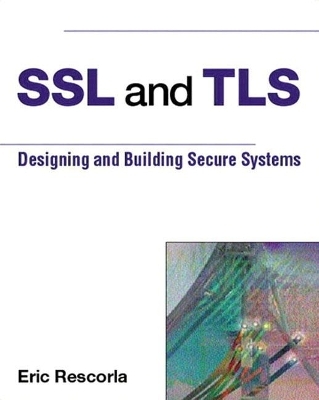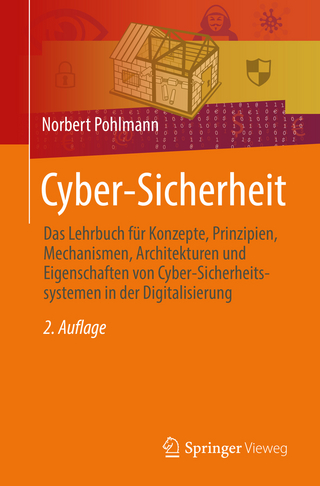
SSL and TLS
Addison Wesley (Verlag)
978-0-201-61598-2 (ISBN)
- Titel ist leider vergriffen;
keine Neuauflage - Artikel merken
Secure Sockets Layer (SSL) is used in virtually every commercial web browser and server. In this book, one of the world's leading network security experts explains how SSL works -- and gives implementers step-by-step guidance and proven design patterns for building secure systems with SSL. Eric Rescorla also provides the first in-depth introduction to Transport Layer Security (TLS), the highly anticipated, maximum-security successor to SSL. Rescorla starts by introducing SSL's fundamentals: how it works, and the threats it is intended to address. One step at a time, he addresses each key SSL concept and technique, including cryptography, SSL performance optimization, designing and coding, and how to work around SSL's limitations. Rescorla demonstrates TLS at work in SMTP-based Internet security applications. The book includes detailed examples of SSL/TLS implementations, with in-depth insight into the key design choices that informed them. For all network and security designers, enterprise developers, system implementers, and suppliers of Internet security products and services.
Eric Rescorla is an Internet security consultant and author of several commercial SSL implementations, including the freely available Java PureTLS toolkit. He is also the author of HTTP over TLS and Secure HTTP IETF RFCs. 0201615983AB04062001
Preface.
1. Security Concepts.
Introduction.
The Internet Threat Model.
The Players.
The Goals of Security.
Tools of the Trade.
Putting It All Together.
A Simple Secure Messaging System.
A Simple Secure Channel.
The Export Situation.
Real Cryptographic Algorithms.
Symmetric Encryption: Stream Ciphers.
Symmetric Encryption: Block Ciphers.
Digest Algorithms.
Key Establishment.
Digital Signature.
MACs.
Key Length.
Summary.
2. Introduction to SSL.
Introduction.
Standards and Standards Bodies.
SSL Over view.
SSL/TLS Design Goals.
SSL and the TCP/IP Suite.
SSL History.
SSL for the Web.
Everything over SSL.
Getting SSL.
Summary.
3. Basic SSL.
Introduction.
SSL Over view.
Handshake.
SSL Record Protocol.
Putting the Pieces Together.
A Real Connection.
Some More Connection Details.
SSL Specification Language.
Handshake Message Structure.
Handshake Messages.
Key Derivation.
Record Protocol.
Alerts and Closure.
Summary.
4. Advanced SSL.
Introduction.
Session Resumption.
Client Authentication.
Ephemeral RSA.
Rehandshake.
Server Gated Cryptography.
DSS and DH.
Elliptic Curve Cipher Suites.
Kerberos.
FORTEZZA.
The Story So Far.
Session Resumption Details.
Client Authentication Details.
Ephemeral RSA Details.
SGC Details.
DH/DSS Details.
FORTEZZA Details.
Error Alerts.
SSLv2 Backward Compatibility.
Summary.
5. SSL Security.
Introduction.
What SSL Provides.
Protect the master_secret.
Protect the Server's Private Key.
Use Good Randomness.
Check the Certificate Chain.
Algorithm Selection.
The Story So Far.
Compromise of the master_secret.
Protecting Secrets in Memory.
Securing the Server's Private Key.
Random Number Generation.
Certificate Chain Verification.
Partial Compromise.
Known Attacks.
Timing Cryptanalysis.
Million Message Attack.
Small-Subgroup Attack.
Downgrade to Export.
Summary.
6. SSL Performance.
Introduction.
SSL Is Slow.
Performance Principles.
Cryptography Is Expensive.
Session Resumption.
Handshake Algorithm and Key Choice.
Bulk Data Transfer.
Basic SSL Performance Rules.
The Story So Far.
Handshake Time Allocation.
Normal RSA Mode.
RSA with Client Authentication.
Ephemeral RSA.
DSS/DHE.
DSS/DHE with Client Authentication.
Performance Improvements with DH.
Record Processing.
Java.
SSL Servers under Load.
Hardware Acceleration.
Inline Hardware Accelerators.
Network Latency.
The Nagle Algorithm.
Handshake Buffering.
Advanced SSL Performance Rules.
Summary.
7. Designing with SSL.
Introduction.
Know What You Want to Secure.
Client Authentication Options.
Reference Integrity.
Inappropriate Tasks.
Protocol Selection.
Reducing Handshake Overhead.
Design Strategy.
The Story So Far.
Separate Ports.
Upward Negotiation.
Downgrade Attacks.
Reference Integrity.
Username/Password Authentication.
SSL Client Authentication.
Mutual Username/Password Authentication.
Rehandshake.
Secondary Channels.
Closure.
Summary.
8. Coding with SSL.
Introduction.
SSL Implementations.
Sample Programs.
Context Initialization.
Client Connect.
Server Accept.
Simple I/O Handling.
Multiplexed I/O Using Threads.
Multiplexed I/O with select().
Closure.
Session Resumption.
What's Missing?
Summary.
9. HTTP over SSL.
Introduction.
Securing the Web.
HTTP.
HTML.
URLs.
HTTP Connection Behavior.
Proxies.
Virtual Hosts.
Protocol Selection.
Client Authentication.
Reference Integrity.
HTTPS.
HTTPS Overview.
URLs and Reference Integrity.
Connection Closure.
Proxies.
Virtual Hosts.
Client Authentication.
Referrer.
Substitution Attacks.
Upgrade.
Programming Issues.
Proxy CONNECT.
Handling Multiple Clients.
Summary.
10. SMTP over TLS.
Introduction.
Internet Mail Security.
Internet Messaging Overview.
SMTP.
RFC 822 and MIME.
E-Mail Addresses.
Mail Relaying.
Virtual Hosts.
MX Records.
Client Mail Access.
Protocol Selection.
Client Authentication.
Reference Integrity.
Connection Semantics.
STARTTLS.
STARTTLS Overview.
Connection Closure.
Requiring TLS.
Virtual Hosts.
Security Indicators.
Authenticated Relaying.
Originator Authentication.
Reference Integrity Details.
Why Not CONNECT?
What's STARTTLS Good For?
Programming Issues.
Implementing STARTTLS.
Server Startup.
Summary.
11. Contrasting Approaches.
Introduction.
The End-to-End Argument.
The End-to-End Argument and SMTP.
Other Protocols.
IPsec.
Security Associations.
ISAKMP and IKE.
AH and ESP.
Putting It All Together: IPsec.
IPsec versus SSL.
Secure HTTP.
CMS.
Message Format.
Cryptographic Options.
Putting It All Together: S-HTTP.
S-HTTP versus HTTPS.
S/MIME.
Basic S/MIME Formatting.
Signing Only.
Algorithm Choice.
Putting It All Together: S/MIME.
Implementation Barriers.
S/MIME versus SMTP/TLS.
Choosing the Appropriate Solution.
Summary.
Appendix A: Example Code.
Chapter 8.
Examples.
Java Examples.
Chapter 9.
HTTPS Examples.
mod_ssl Session Caching.
Appendix B: SSLv2.
Introduction.
SSLv2 Overview.
Missing Features.
Security Problems.
PCT.
What about SSLv1?
Bibliography.
Index. 0201615983T04062001
| Erscheint lt. Verlag | 1.11.2000 |
|---|---|
| Verlagsort | Harlow |
| Sprache | englisch |
| Maße | 188 x 232 mm |
| Gewicht | 820 g |
| Themenwelt | Informatik ► Netzwerke ► Sicherheit / Firewall |
| Informatik ► Theorie / Studium ► Kryptologie | |
| ISBN-10 | 0-201-61598-3 / 0201615983 |
| ISBN-13 | 978-0-201-61598-2 / 9780201615982 |
| Zustand | Neuware |
| Haben Sie eine Frage zum Produkt? |
aus dem Bereich


